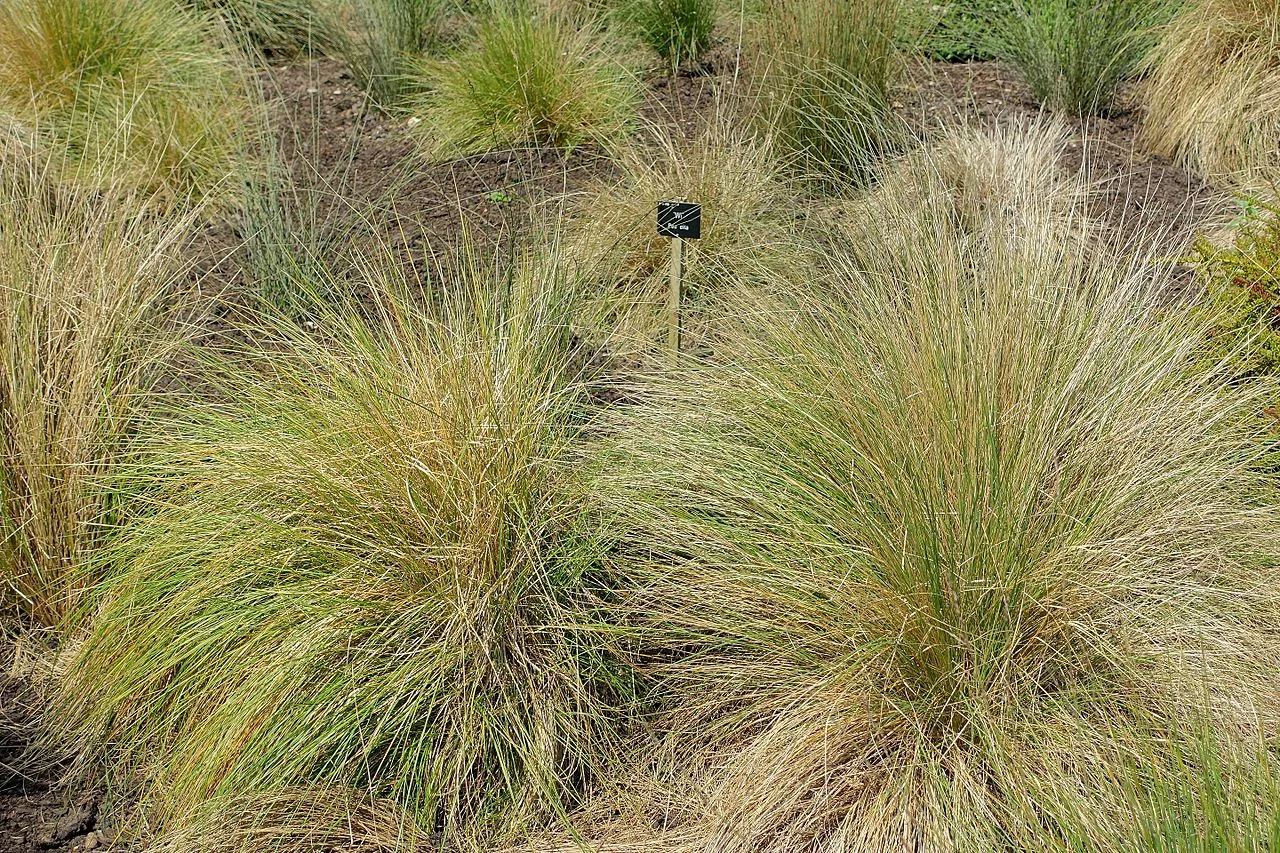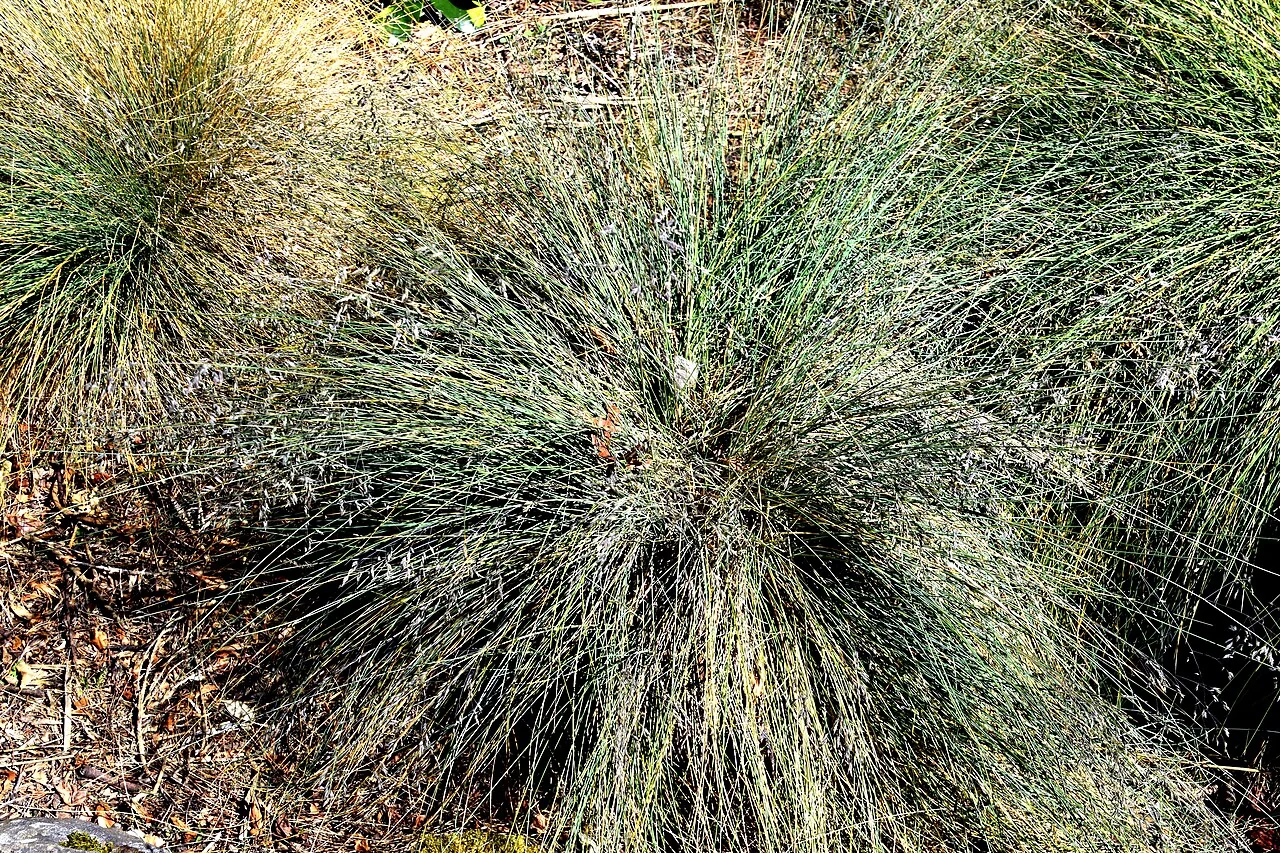
Coastal Tussock
Poa billardierei
A hardy, yellow-green tussock grass ideal for coastal environments, dune stabilization, and naturalistic designs; excellent for texture and resilience. Learn more in our native plants guide .

Plant Description
Botanical Features
Coastal Tussock ( Poa billardierei ), also known as Sand Tussock or Hinarepe, is a dense, clump-forming, evergreen grass native to New Zealand and temperate Australia. It typically forms distinctive yellow-green tussocks that can reach heights of 0.7 to 1 meter. Its leaves are fine, rolled, and somewhat drooping, initially green but often fading to a silvery hue at the tips and drying to a golden-straw colour. The foliage forms dense, stiff mounds, creating a resilient and textured effect. In season, it produces seed-heads that are typically no longer than the leaves, containing relatively large, barley-like seeds. The plant has a dense, stiff, rhizomatous structure, contributing to its robust nature.
Quick Facts
Overview
| Scientific Name | Poa Billardierei |
|---|---|
| Height | 0.7-1 m |
| Spread | 0.5-1 m clump |
| Light | Full sun |
| Water Needs | Low once established |
| Frost | Good |
| Frost Tolerance | Highly tolerant |
| Salt Tolerance | Highly tolerant |
| Growth Rate | Moderate |
| Lifespan | Perennial |
Climate Best Suited to
Coastal Tussock demonstrates exceptional adaptability across New Zealand's diverse climatic regions, with particularly strong performance in coastal environments where its natural resilience to harsh conditions becomes most apparent. This hardy native grass thrives in temperate oceanic climates characterized by moderate temperatures, salt-laden air, and variable precipitation patterns typical of New Zealand's coastal zones. The species shows remarkable tolerance to temperature fluctuations, handling both the mild maritime conditions of northern regions and the cooler, more variable weather patterns of southern areas. Its natural distribution across both North and South Islands demonstrates inherent climate adaptability, making it suitable for cultivation in virtually all major New Zealand population centers. Regional climate suitability extends across major New Zealand cities, with particularly strong performance in coastal areas where natural conditions closely match the plant's preferred habitat requirements.
Regional Suitability
| City | Climate Suitability |
|---|---|
| Whangārei | Ideal |
| Auckland | Ideal |
| Hamilton | Ideal |
| Tauranga | Ideal |
| Rotorua | Ideal |
| Gisborne | Ideal |
| New Plymouth | Ideal |
| Napier | Ideal |
| Whanganui | Ideal |
| Palmerston North | Ideal |
| Wellington | Ideal |
| Nelson | Ideal |
| Christchurch | Ideal |
| Dunedin | Ideal |
| Invercargill | Ideal |
Natural Habitat
Coastal Tussock ( Poa billardierei ) is a resilient, clump-forming, evergreen grass native to New Zealand and temperate Australia. It is primarily found in coastal environments, demonstrating a strong adaptation to harsh conditions.
Key Habitats Include:
- Coastal Dunes: A prominent species in foredunes and dune hollows, playing a crucial role in dune stabilization.
- Sandy and Rocky Shores: Thrives in sandy and rocky areas directly adjacent to the coast.
- Exposed Coastal Sites: Well-suited to open, windy coastal locations where other plants may struggle.
Distribution:
In New Zealand, it is distributed across the North Island, South Island, and historically the Chatham Islands (though now apparently absent there). It is also found in temperate regions of Australia.
Preferred Conditions:
- Soil: Prefers well-drained, sandy soils. It is adapted to lean conditions, and rich soils or heavy fertilizers should be avoided.
- Moisture: Highly drought-tolerant once established, but requires regular watering during its establishment phase.
- Light: Thrives in full sun.
- Tolerance: Highly tolerant of frost, strong winds, and salt spray, making it an excellent choice for exposed coastal gardens.
The presence of Poa billardierei in these diverse coastal habitats highlights its ecological importance in contributing to the biodiversity and stability of New Zealand's and Australia's coastal landscapes, particularly in open and exposed environments.
Plant Conservation
Poa billardierei , commonly known as Coastal Tussock, is a grass species native to New Zealand and temperate Australia. In New Zealand, it was classified as "At Risk - Declining" in 2017, with qualifiers indicating data poor, range restricted, and naturally uncommon. In Victoria, Australia, it was categorized as "Rare" in 2014 and has been proposed as "Endangered" due to ongoing decline.
Key Threats:
- Mammalian Grazing and Browsing: Animals such as sheep, cattle, goats, horses, and rabbits pose a significant threat.
- Competition from Invasive Species: Non-native plants like marram grass ( Ammophila arenaria ) and Euphorbia paralias outcompete native populations.
- Coastal Development: Habitat loss and fragmentation due to human development along coastlines.
- Vehicle Use: Damage to coastal habitats from off-road vehicles.
Conservation efforts and management strategies for Poa billardierei focus on protecting its remaining habitats, controlling invasive species, and promoting its use in ecological restoration projects, particularly for sand dune stabilization. Its resilience and ability to thrive in harsh coastal conditions make it a valuable species for these initiatives.
Growing Requirements
Soil
Well-drained, sandy soils; avoid rich soils, heavy fertilizers, and prolonged waterlogging.
Light
Full sun is preferred for optimal growth and colour.
Water
Keep evenly moist while establishing; highly drought-tolerant once mature.
Temperature
Hardy and highly tolerant of frost in most coastal regions.
For Coastal Tussock ( Poa billardierei ), choose a site with full sun and well-drained, sandy soil. Avoid incorporating rich compost or heavy fertilizers, as it is adapted to lean conditions. Plant with the crown or root collar at soil level, then apply a light mulch (e.g., gravel) to moderate temperature and conserve moisture. Protect young plants from extreme conditions while establishing.
Planting Guide
Coastal Tussock is a robust and adaptable native grass, relatively easy to establish and maintain, especially in its preferred coastal environments. Its distinctive yellow-green foliage and resilience make it an excellent choice for dune stabilization and naturalistic coastal garden designs.
1. Site Selection:
- Sunlight: Coastal Tussock thrives in full sun. An open, sunny spot is ideal for vigorous growth.
- Soil: It prefers well-drained, sandy soils. It is highly adaptable to various soil conditions but performs best in lean, free-draining substrates. Good drainage is critical to prevent root rot.
- Exposure: It is exceptionally tolerant of coastal conditions, including high winds, salt spray, and frost, making it perfect for seaside gardens, exposed banks, or dune restoration.
2. Planting Instructions:
- When to Plant: The best time to plant Coastal Tussock is in spring or autumn, when temperatures are mild and rainfall is more reliable. This allows the plant to establish its root system before extreme weather.
- Preparation: Prepare the planting site by clearing weeds. Avoid heavy soil amendments; Coastal Tussock prefers lean, sandy conditions. Dig a hole that is twice the width of the root ball and to the same depth.
- Placement: Gently remove the plant from its container, minimizing root disturbance. Plant at the same level as it was in the container. Backfill the hole with soil, gently firming it around the roots to remove air pockets.
- Watering: Water thoroughly immediately after planting to settle the soil.
- Spacing: For mass planting or dune stabilization, space plants about 50-70 cm apart to allow them to form a continuous cover. For individual specimens, allow at least 1 meter for its mature spread.
3. Ongoing Care:
- Watering: Water regularly during the first year to help establish a strong root system. Once established, it is highly drought-tolerant and requires minimal watering, only during prolonged dry spells.
- Mulching: Apply a light layer of gravel or bark mulch around the base of the plant to retain moisture, suppress weeds, and regulate soil temperature. Keep the mulch clear of the crown to prevent rot.
- Fertilizing: Avoid heavy fertilization. A light application of a balanced organic fertilizer in spring can support healthy growth, but it is adapted to low-nutrient soils.
- Pruning: Coastal Tussock requires minimal pruning. Trim old or spent foliage in late winter to encourage fresh growth and maintain a tidy appearance.
- Pests and Diseases: It is generally disease and pest-free. Monitor for any signs of stress or unusual growth, particularly ensuring good drainage to prevent crown rot.
Ecosystem Notes
- Soil protection: Dense tussocks and extensive root systems are crucial for stabilizing coastal sands and preventing erosion.
- Habitat Provision: Provides shelter and food for small birds, lizards, and insects in coastal ecosystems.
- Associates: Often found with other coastal dune species, contributing to the unique biodiversity of these environments.
Uses and Significance
Garden and Restoration
Coastal Tussock is highly valued for its ecological role in coastal environments and its aesthetic appeal in landscaping. Its resilience makes it an excellent choice for challenging sites.
- Dune stabilization and erosion control
- Coastal gardens and naturalistic plantings
- Mass plantings for texture and movement
Its ability to thrive in exposed, sandy conditions makes it a key species for restoring degraded coastal habitats and creating resilient landscapes.
Landscaping Ideas
Coastal Resilience and Texture
- Mass planting: Create sweeping drifts in coastal gardens or for large-scale dune restoration projects.
- Feature plant: Use as a focal point in rock gardens or alongside paths in sandy, exposed areas.
- Mixed plantings: Combine with other drought-tolerant and salt-tolerant native plants for a robust and attractive coastal landscape.
Seasonal Care Calendar
Spring
- Plant new stock
- Light fertilization (if needed)
- Monitor for new growth
Summer
- Minimal watering (once established)
- Monitor for pests/diseases
Autumn
- Collect seeds
- Consider division of mature clumps
- Top up mulch if necessary
Winter
- Trim old or spent foliage
- Ensure good drainage
Pruning and Maintenance
Techniques and Timing
Coastal Tussock requires minimal but strategic pruning to maintain its natural form and healthy growth patterns. The key approach involves selective removal of old, damaged, or spent foliage while preserving the plant's characteristic tussock architecture. Annual pruning is best performed in late winter or early spring, just before the new growing season begins, allowing the plant to channel energy into fresh, vigorous growth. Focus primarily on removing brown, weathered, or damaged fronds that may harbor pests or diseases, cutting these back to the crown level with sharp, clean pruning tools. Avoid heavy pruning or cutting into the green, healthy foliage unless absolutely necessary, as this can stress the plant and compromise its drought tolerance. Light grooming throughout the growing season can help maintain appearance by removing any obviously dead or damaged material, but major pruning should be confined to the dormant season to minimize stress and maximize recovery potential.
Trim old or spent foliage of Coastal Tussock in late winter or early spring to encourage fresh growth from the base. Avoid harsh cuts into the crown.
How to Grow Coastal Tussock
Coastal Tussock ( Poa billardierei ) is a hardy, resilient grass that can be successfully propagated from seed or by division. It thrives in well-drained, sandy soils and full sun, making it ideal for coastal and exposed sites.
From Seed
Collect fresh, ripe seeds in mid to late summer or autumn. Sow thinly on the surface of a free-draining seed-raising mix (e.g., 50:50 peat:sand), covering very lightly with fine medium. Keep the mix evenly moist and provide bright light at cool to mild temperatures (around 10-18°C). Germination typically occurs within two months without special pretreatment. Prick out crowded seedlings into cell trays or small pots once large enough to handle, growing them on with good light and steady moisture. Harden off young plants before transplanting outdoors.
Division of Clumps
Established clumps can be divided in autumn (after flowering) or early spring (before new growth begins), when soil moisture is reliable. Carefully lift the entire plant and gently separate the clump into sections, ensuring each division has several healthy growing points and a good root system. Replant divisions at the same depth as the original plant. Water thoroughly after replanting to settle the soil and keep evenly moist until the divisions are re-established.
Planting and Establishment
Plant in full sun with well-drained, sandy soil; avoid waterlogged sites. Space plants to allow for natural spread and good airflow. Water regularly through the first growing season to encourage a strong root system, then reduce frequency as the plant becomes drought-tolerant. Apply a light, balanced slow-release fertilizer in spring if growth appears weak, but avoid over-fertilizing. Annually, trim old or spent foliage to refresh the clump and maintain a tidy habit.
Pests and Diseases
Resilient in Lean, Dry Conditions
- Crown rot: Primarily a risk in rich, wet, or poorly drained soils. Ensure excellent drainage and avoid overwatering.
- General Pests/Diseases: Generally robust and resistant to most pests and diseases when grown in suitable conditions.
- Grazing: Vulnerable to browsing by mammalian herbivores in natural habitats.
Cultural Significance
Poa billardierei , or Coastal Tussock, holds significant ecological and cultural value, particularly in its native coastal environments. As an endemic grass, it is a vital component of New Zealand's and Australia's unique coastal ecosystems, contributing to biodiversity and landscape stability.
Ecological Importance:
- Dune Stabilization: Its dense tussock formations and extensive root systems are crucial for stabilizing coastal dunes, preventing erosion, and building new dune structures.
- Habitat and Food Source: Provides essential shelter and food for various native fauna, including small birds, lizards, and insects, within coastal habitats. Its seeds can also be a food source for grazing animals.
Restoration and Landscaping:
In contemporary settings, Poa billardierei is highly valued for its aesthetic appeal in naturalistic designs and its practical application in ecological restoration. Its hardiness and adaptability to harsh coastal conditions make it an indispensable species for revegetating degraded dune systems and creating resilient, low-maintenance coastal gardens.
Traditional Uses:
While specific traditional Māori medicinal uses for Poa billardierei are not widely documented, grasses in general have historically played various practical roles in indigenous cultures, including for weaving, shelter, and as food sources. Its role in stabilizing land would have been recognized and valued.
Bonus Tip
For optimal health and appearance, ensure Coastal Tussock is planted in a location with excellent drainage, as this native grass's greatest enemy is waterlogged soil conditions. Poor drainage represents the species' primary weakness and can quickly lead to crown rot, root decay, and plant death, particularly during cooler months when soil temperatures are lower and evaporation rates reduced. Choose planting sites on slopes, raised areas, or naturally well-draining soils, and consider improving heavy clay soils with coarse sand, gravel, or organic matter to enhance drainage characteristics. When establishing new plantings, create slightly raised planting mounds or berms to ensure water moves away from the crown area, preventing the accumulation of moisture around sensitive root zones. In areas with naturally poor drainage, consider installing subsurface drainage systems or selecting alternative planting locations that better match the species' requirements for free-draining conditions.







